Specialist homelessness services client pathways: Young clients aged 18 to 24 in 2018–20
Citation
AIHW
Australian Institute of Health and Welfare (2023) Specialist homelessness services client pathways: Young clients aged 18 to 24 in 2018–20, AIHW, Australian Government, accessed 27 April 2024.
APA
Australian Institute of Health and Welfare. (2023). Specialist homelessness services client pathways: Young clients aged 18 to 24 in 2018–20. Retrieved from https://pp.aihw.gov.au/reports/homelessness-services/shs-young-clients-aged-18-to-24-in-2018-20
MLA
Specialist homelessness services client pathways: Young clients aged 18 to 24 in 2018–20. Australian Institute of Health and Welfare, 12 September 2023, https://pp.aihw.gov.au/reports/homelessness-services/shs-young-clients-aged-18-to-24-in-2018-20
Vancouver
Australian Institute of Health and Welfare. Specialist homelessness services client pathways: Young clients aged 18 to 24 in 2018–20 [Internet]. Canberra: Australian Institute of Health and Welfare, 2023 [cited 2024 Apr. 27]. Available from: https://pp.aihw.gov.au/reports/homelessness-services/shs-young-clients-aged-18-to-24-in-2018-20
Harvard
Australian Institute of Health and Welfare (AIHW) 2023, Specialist homelessness services client pathways: Young clients aged 18 to 24 in 2018–20, viewed 27 April 2024, https://pp.aihw.gov.au/reports/homelessness-services/shs-young-clients-aged-18-to-24-in-2018-20
Get citations as an Endnote file: Endnote
On this page:
Introduction
Youth homelessness can have a profound impact on the lives of young people in Australia and as such children and young people are a priority homelessness cohort (see Children and young people for more detailed information about young people and homelessness).
Longitudinal analyses have been undertaken for a cohort of young clients aged 18 to 24 who received specialist homelessness services sometime in 2018–20 (Figure Young1820.1; See Introduction to the SHS longitudinal data for details on the longitudinal analyses undertaken).
A comparison cohort (2018–20 non-young) was created, comprising of clients who received SHS support at any time during 2018–20 and who were aged 25 years and over.
More information on the how comparison cohorts were derived can be found in the Methodology section.
The defining study period is the 24 months from the start of the first support period for each client between July 2018 and June 2020. The retrospective study period for this cohort is the 84 months (or 7 years) before the start of the defining study period.
Key findings
- Nearly two-thirds (64%) of SHS clients aged 18 to 24 who received support in 2018–20 were female.
- Almost half (45%) of the 2018–20 young cohort had a current mental health issue during the defining period.
- Around two-thirds (63%) of the 2018–20 young cohort were homeless at some time in the defining period and 41% had been couch surfing at some time.
- 2018–20 young cohort clients were more likely to have family-related issues as reasons for seeking assistance, such as relationship/family breakdown.
- Over 4 in 5 young clients were not employed sometime in the defining period.
- Young clients aged 18 to 24 in 2018–20 were over 4 times more likely than the comparison cohort to need training assistance or pregnancy assistance.
Figure Young1820.1: Young cohort 2018–20, longitudinal analysis overview
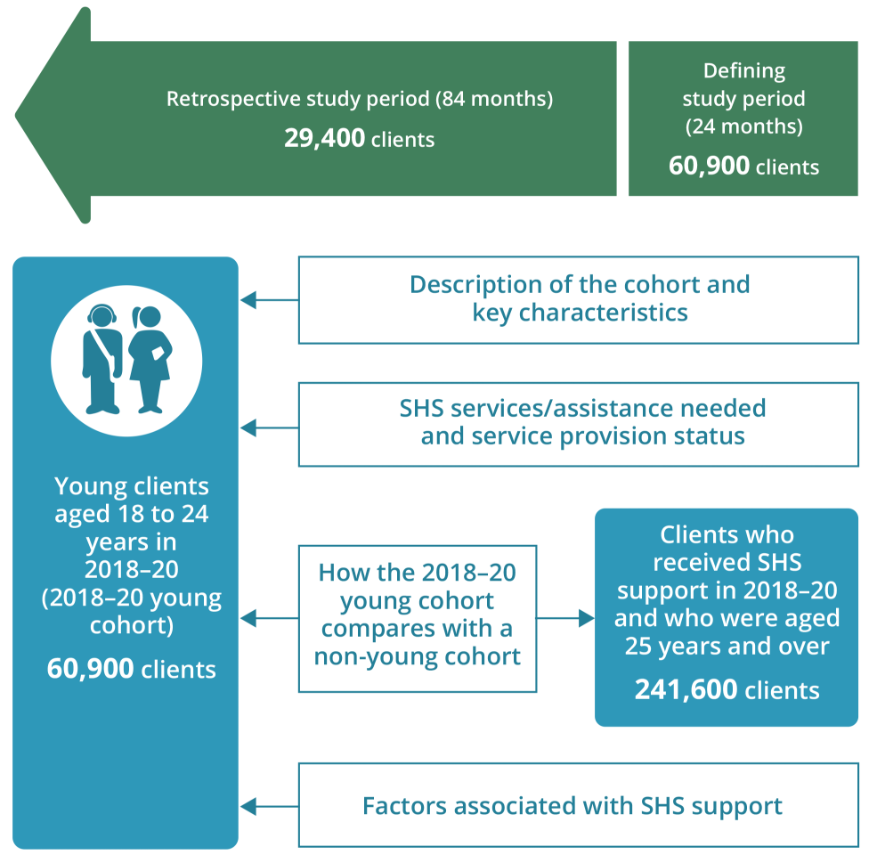
Source: AIHW analysis of SHS longitudinal data 2011–22, Table Young1820.1.
Key characteristics of the 2018–20 young cohort
Over 60,900 young clients aged 18 to 24 received SHS services in 2018–20; these clients had the following key characteristics (Figure Young1820.2, Table Young1820.1, Table Young1820.2):
- Nearly two-thirds (64%, 39,000 clients) were female.
- Over 30% (18,500 clients) were Indigenous Australians.
- 11% (7,000 clients) were born overseas.
- Almost half (47%, 28,600 clients) received only one episode of support in 2018–20.
- Almost half (48% or 29,400 clients) had received SHS support at some point in the 84 months before the defining study period.
- Nearly two-thirds (63% or 38,400 clients) were homeless at some time during the defining study period.
- 33% (20,000 clients) received accommodation during the defining study period.
- Of the 38,400 clients that had experienced homelessness, almost two-thirds (25,200 clients) had been couch-surfing at some time.
- Almost half (45% or 27,100 clients) had a current mental health issue during the defining study period, and nearly 15% (9,000 clients) had problematic drug and/or alcohol issues.
- Around 40% (24,500 clients) had experienced family and domestic violence during the defining study period.
Figure Young1820.2: Young clients aged 18 to 24 in 2018–19, client key characteristics, by study period
This interactive bar chart shows a comparison between the young and non-young cohorts, in terms of key characteristics and across two study periods (defining and retrospective). A radio button allows selection for the individual state/territory and Australia. For Australia, young clients were more likely to be Indigenous (Young clients 30% compared with 21% non-young clients) and more likely to be couch surfer (41% compared with 24%).They were also more likely to have relationship/family breakdown as reason for seeking assistance (36% compared with 21%).
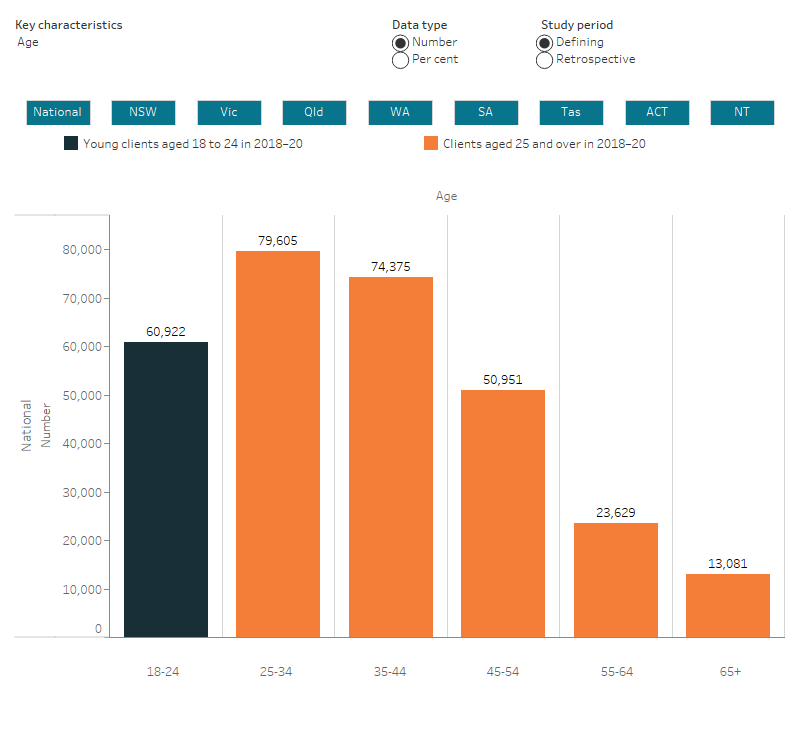
Notes
- Counts of clients with values of No include cases where the variable is not stated or unknown.
- Clients are counted as Indigenous or overseas-born if they are classified as such in any support period in the longitudinal data.
- Percentages are calculated using total clients within the cohort as the denominator (Young cohort: 60,922, non-young cohort: 241,641). For the retrospective and prospective study periods the percentages may not add to 100 as not all cohort clients are included in these periods.
- Received accommodation indicates that the client was provided either short-term or emergency accommodation, medium term/transitional housing, or long-term housing.
- Short-term clients received SHS services only during the defining study period. Historical clients received SHS services in the retrospective and defining study periods. Ongoing clients received SHS services in the defining and prospective study periods. Long-term clients, received SHS services in all three study periods.
- Reason refers to the reasons a client presented to any specialist homelessness services agency during the study period.
- The variable Ever Presented Alone refers to whether a client was ever recorded as having presented for support (that is, started a support period) alone. Unlike many other variables, this is only recorded in the SHS data at the start of support periods. Counts of clients with values of No include cases where the variable is not stated or unknown. Note: for children, there may be instances where the child physically presented with an adult to an agency, but only the child required and received SHSC services, or where the child was not correctly linked to the group when the support period was opened.
- The variable Presented with child(ren) indicates whether the client presented for support (that is, started a support period) as part of a group which contained one or more children.
Source: AIHW analysis of SHS longitudinal data 2011–22, Table YOUNG1820.1.
Service engagement profiles
SHS support patterns of the young clients aged 18 to 24 in 2018–19 cohort for the period 2011–22 were examined. Over half (31,600 clients or 52%) were short-term clients, receiving services only during the 24-month defining study period (Table Young1820.1). The other half (48% or 29,400 clients) of the 2018–20 young cohort had received SHS support both in the retrospective and defining study periods. The service engagement pattern was generally consistent among states and territories, however, there were less historical clients in Western Australia (42%) and a higher proportion of historical clients in South Australia (56%).
Vulnerability pathways
Using data for the period 2011–22, client profiles for the 2018–20 young cohort were analysed for the presence of vulnerabilities including mental health issues, drug and/or alcohol problems, and experience of family and domestic violence (FDV) within each of the two study periods – the retrospective and defining periods (Table1, Table Young1820.3). For more information on the derivation of these vulnerabilities, see Methodology.
Nearly half (45% or 27,100 clients) of the 2018–20 young cohort had mental health issues in the defining period. Of these, 9,900 clients (36% of clients with mental health issues in the defining period) were clients in the retrospective period and had mental health issues at the time of support while 12,100 clients (45%) were not SHS clients in the retrospective period.
There were 24,500 (40%) clients in the 2018–20 young cohort who had experienced FDV in the defining period. Of these, 34% were clients in the retrospective period and had experience FDV and 47% were not SHS clients in the retrospective period.
SHS services needed by 2018–20 young cohort clients
The need for, and provision/referral of, SHS services was examined for young clients in the retrospective and defining study periods; aggregation is based on services needed or provided/referred in support periods that commenced within each study period only.
Patterns of service need were generally similar for the young clients across the two study periods (Figure Young1820.3, Table Young1820.1, Table Young1820.4). For example, the proportion of 2018–20 young cohort clients with a need for accommodation assistance (all forms) ranged from 80% in the defining to 87% in the retrospective period. Typically, young clients needed long-term housing (needed by 52% of clients in the defining period) or short-term housing (needed by 51% of clients in the defining period).
Figure Young1820.3: Young clients aged 18 to 24 in 2018–20, select top 8 services and assistance needed and service provision status by study period
The interactive stacked horizontal bar graph shows the select top 10 services needed and the provision/referral status for the 2018–20 Young cohort clients (60,900 clients) who received support in the retrospective and defining study periods. Across two study periods, long-term housing was one of the most needed services, around 33% of these clients were either provided this service or referred to another agency. Material aid/brokerage was also a key service needed by this cohort; this service was provided/referred to over 92% of clients.
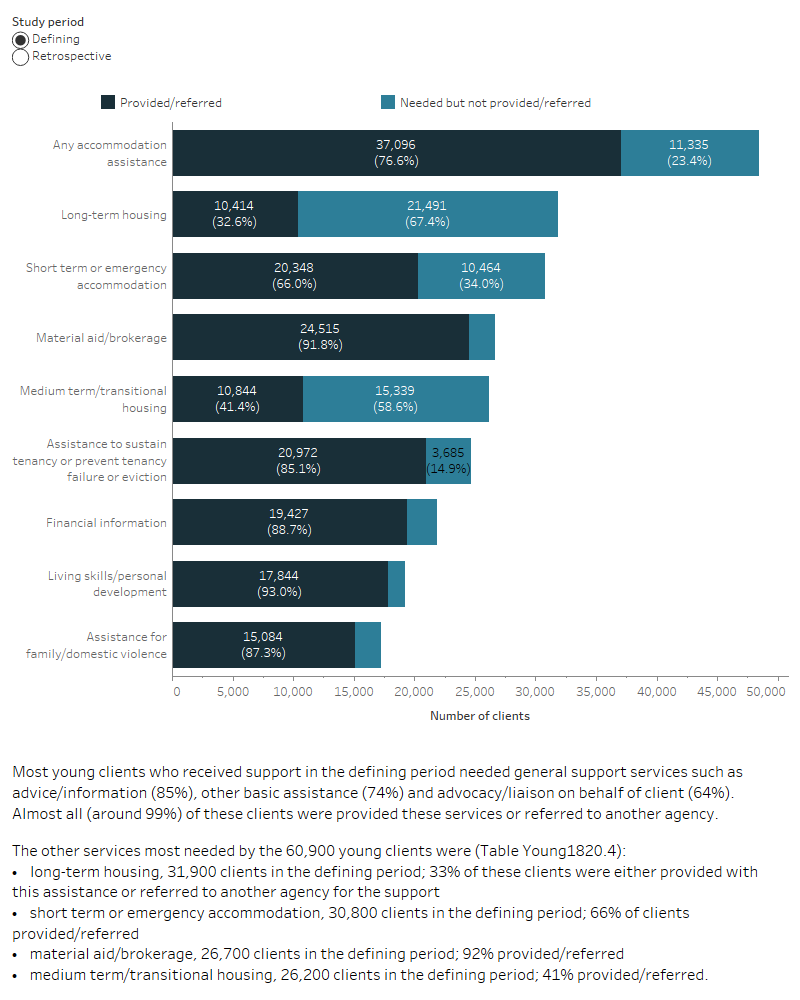
Notes
- Percentages are based on the number of clients who needed the service in each study period as the denominator.
- Any accommodation assistance refers to need or provision of any of short-term or emergency accommodation, medium term/transitional housing, long-term housing, assistance to sustain tenancy or prevent tenancy failure or eviction, assistance to prevent foreclosures or for mortgage arrears.
- The services Other basic assistance, Advice/information and Advocacy/liaison on behalf of client have not been included in the top 10 shown above.
Source: AIHW analysis of SHS longitudinal data 2011–22, Table YOUNG1820.4.
How the 2018–20 young cohort compares with the 2018–20 non-young cohort
There were approximately 241,600 SHS clients who received SHS support in 2018–20 aged 25 years and over. Compared with these clients, during the defining period, the 2018–20 young cohort clients were (Figure Young1820.2, Table Young1820.1):
- more likely to have experienced homelessness (63% of the young cohort compared with 51% of the non-young group), including having been a couch surfer (41% compared with 24%)
- more likely to need accommodation was with 43% of young clients needing medium-term accommodation (compared with 31%), 52% needed long-term accommodation (compared with 45%) and 51% need short-term accommodation (compared with 44%)
- more likely to have family-related issues as reasons for seeking assistance, such as relationship/family breakdown (36% compared with 21%), time out from family/other situation (21% compared with 10%) and lack of family and/or community support (32% compared with 24%)
- more likely to have a current mental health issue (45% compared with 40%) and equally likely to have had problematic drug or alcohol issues (15% compared with 14%).
How did service needs differ?
Differences in identified service need were examined using relative risk, between young clients and clients aged 25 and over in 2018–20 receiving SHS support. Relative risk was calculated by dividing the risk of an event occurring for one group (specifically, service need for each service type separately for the 2018–20 young cohort clients) by the risk of an event occurring for another group (service need for the 2018–20 non-young cohort clients).
Young clients aged 18 to 24 in 2018–20 were more than 4 times more likely to need training assistance or pregnancy assistance in the defining period (relative risks 4.50 and 4.41, respectively) (Figure Young1820.4; Table Young1820.5), they were also more likely to need training assistance or educational assistance in the retrospective period (relative risks 3.62 and 3.28).
Young clients aged 18 to 24 in 2018–20 were less likely to need interpreter services in both the defining and retrospective study periods (RR 0.49 and 0.55, respectively).
Figure Young1820.4: Relative risk for services needed, young clients aged 18 to 24 in 2018–20
The interactive risk ratio plot shows the differences in service need between young and non-young clients receiving SHS support in the two retrospective and defining study periods, these associations are presented as relative risks. The top 4 services more likely to be needed by young cohort clients compared with non- young clients (that is, those with the largest relative risk) have been shown in the figure. A radio button allows selection of the services and relative risks for each of the study periods (defining and retrospective). Young clients were 4 to 5 times more likely to need training assistance (relative risk [RR] 4.50) and pregnancy assistance (relative risk [RR] 4.41) during the 2018–20 defining study period than clients in the non-young cohort. Compared to non-young clients, young clients had much less need for interpreter service (relative risk [RR] 0.49).
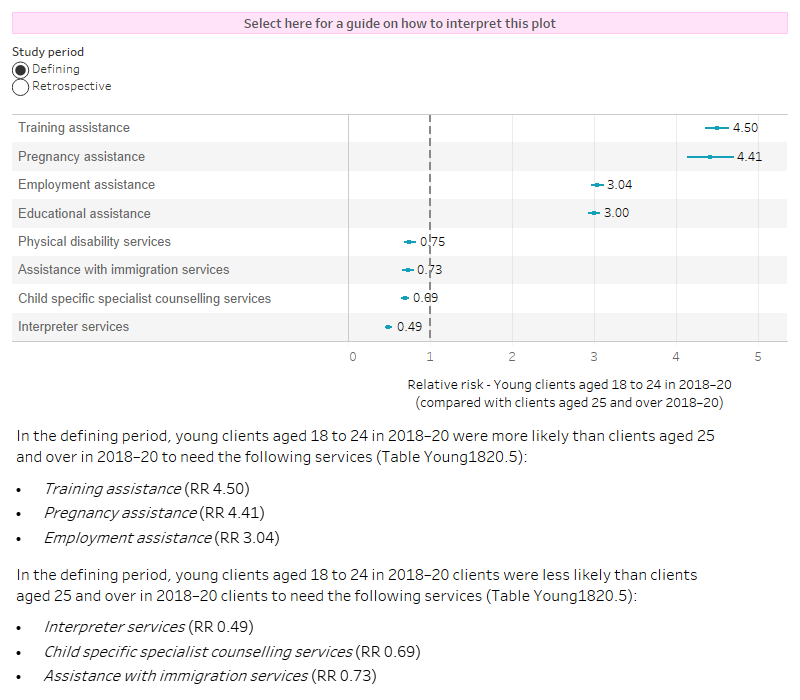
Note: Relative risk is derived by comparing two groups for their likelihood (risk) of an event. It is calculated by dividing the probability of a cohort client needing a SHS service/assistance divided by the probability of a non-cohort client needing a SHS service/assistance.
Source: AIHW analysis of SHS longitudinal data 2011–22, Table YOUNG1820.5.
Factors associated with SHS support
Descriptive regression models were used to examine whether client characteristics or support experience in the defining period were associated with receipt of SHS support in the retrospective study period (historical service use). Information on interpreting regression models can be found in the section Understanding factors associated with past and future support. Two models were created; a ‘client characteristic’ model (Model 1) that contained client characteristics and a ‘reasons’ model (Model 2) that supplemented these characteristics with flags for the 26 possible reasons why the client sought support during the defining study period. Multiple regression is used, which in this case means that the effect of each variable is measured while keeping the effects of all other variables in the model constant.
Variations in state and territory specific policies and service delivery models mean that the likelihood of a client receiving services in the past varies among states and territories. Therefore, in addition to a national model, separate regression models were created for each state or territory where there was sufficient sample size (at least 3,500 clients; Table Young1820.1). The models are descriptive, that is, they are intended to describe the client variables that are associated with past service use without proposing or testing specific causal pathways.
The outcome variable (receipt of SHS support) was a binary measure (yes or no) and did not distinguish between clients that needed SHS services only once in the retrospective study period and clients that required frequent support.
Risk ratios were created to measure the association between the use of SHS services and a set of client characteristics (see Glossary entry on Relative risk for how to interpret the results)
The results from the client characteristic model (Model 1) demonstrates that although different in magnitude in each state or territory, the characteristics in the defining period that had the greatest association with past SHS support when all other factors are taken into consideration were (Figure Young1820.5, Table Young1820.6):
- starting a period of support in public or community housing, and ending that period of support in a different housing situation (1.32 times more likely)
- having transitioned from custody (1.26 times more likely)
- Indigenous Australians using SHS services in the defining period (2018–20) were 1.23 times as likely as non-Indigenous Australians to have used SHS is the past.
Factor associated with a reduced likelihood of using services in the past was being born overseas (8% lower likelihood).
The reasons model (Model 2; Figure Young1820.6) demonstrates that, in addition to similar associations as shown in Model 1, having financial difficulties or a housing crisis as reasons for seeking assistance in the defining period, were associated with an increased likelihood of past SHS support (1.11 times more likely, in the national data).
Figure Young1820.5: Relative risk for use of SHS services (young clients aged 18 to 24 in 2018–20)
The interactive risk ratio plot shows the characteristics or reasons for presenting that are associated with the young cohort clients’ use of SHS services in the past (retrospective), these associations are presented as relative risks. Relative risks for all states and territories and Australia can be selected and displayed. Two regression models can be selected, Model 1 contains client characteristics and experiences in the defining period, Model 2 contains client characteristics and the reasons for seeking support in the defining study period. Nationally, having started support in public or community housing and ended elsewhere, or having transitioned from custody, or having had problematic drug/alcohol issues at some time during the defining study period had the strongest association with past SHS support.
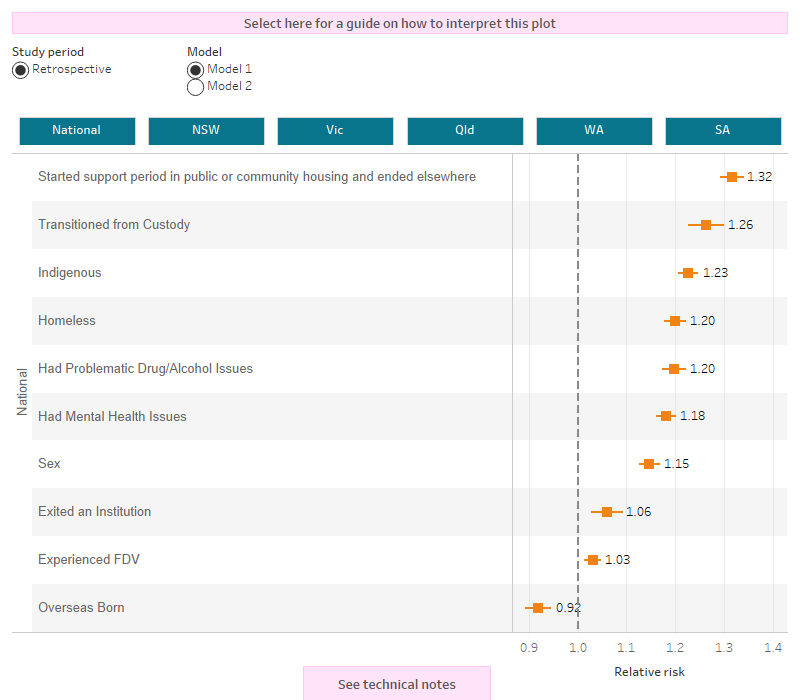
Notes
- Apart from overseas-born and Indigenous, all other parameters capture whether a client ever experienced that situation in the defining period (for example, homeless captures whether the client was homeless at any time during a support period in the defining study period).
- Not employed means unemployed or not in the labour force.
- Presented with child(ren) means that the client started at least one support period in the defining study period with one or more children.
- Model 1 contains client characteristics and experiences in the defining period, Model 2 contains client characteristics and also the reasons for seeking support in the defining study period.
Source: AIHW analysis of SHS longitudinal data 2011–22, Table YOUNG1820.6.
Summary
The 2018–20 young cohort contained over 60,900 young clients aged 18 to 24 in 2018–20. The majority (64%) were female and 30% were Indigenous. Almost half (48%) had received SHS support in the past and almost a third (32%) had three or more support periods in the defining period from July 2018 to June 2020.
Young clients were more likely to have family-related issues such as relationship/family breakdown, lack of family and/or community support and time out from family/other situation as reasons for seeking assistance.
During both the defining and retrospective study periods, young clients aged 18 to 24 in 2018–20 were 4 times more likely to need training assistance and 3 times more likely to need pregnancy assistance or employment assistance.


